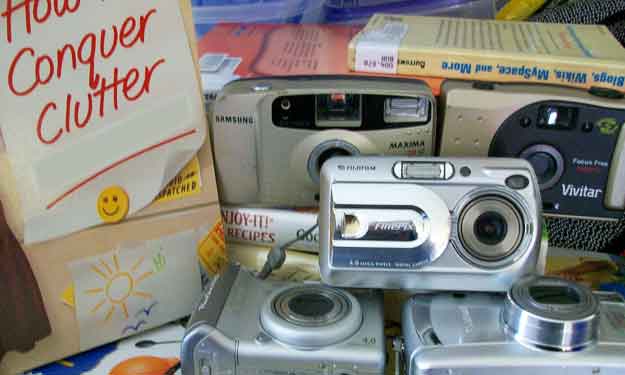The 10 Commandments of Clutter

How to Conquer Clutter.
How to Conquer Clutter and Keep it Under Control
Most of us have too much clutter and junk in our homes. Clutter allows dust, dirt, grime, germs, and allergens to accumulate, creating a potentially unhealthy environment. It’s also visually unappealing and gives off negative vibes. To tackle this issue, follow the 10 Commandments of Clutter Control and keep these in mind:
- Define specific and achievable goals for decluttering. Break down the task into smaller, more manageable steps.
- Allocate dedicated time for decluttering in your schedule. Treat it as you would any other important commitment. This helps establish a routine and makes it more likely that you’ll follow through.
- If a decluttering task takes less than two minutes, do it immediately. Tackling small tasks can create momentum and make the overall process feel less overwhelming.
- Envision the benefits of a clutter-free and organized space. Whether it’s increased productivity, reduced stress, or a more visually appealing environment, keeping the end goal in mind can be motivating.
- Begin with a small, manageable areas. Completing a smaller task can boost your confidence and provide a sense of accomplishment, making it easier to tackle larger areas later.
- When you declutter and organize a space have garbage bags and containers labeled and ready for the Keep Pile, Donate Pile, Trash Pile, and Relocate Pile. As you go through items, place each into one of these categories. This will help you streamline decisions and keeps you focused.
1. Stop Procrastinating and Clear the Clutter
Start by building good habits. Don’t put off what you can do today, especially if you know you’re unlikely to do it tomorrow.
With work and family demands, it can be hard to find time to manage clutter. If you keep procrastinating, the clutter will only grow.
Make the tough decisions now. Set aside just 15 minutes each day to tackle a new area in your home.
Overcoming procrastination and clearing clutter can be challenging, but it’s worth it. Taking small steps is perfectly fine.
2. Stop Making Excuses for Not Reducing Clutter
No more excuses.
You know it needs to be done, and clutter won’t disappear on its own. Just 15 minutes a day can make a big difference.
Start with one small area, like a kitchen counter, and tackle it.
You’ve got this! Believe in yourself, and you can keep the clutter away for good.
3. Use It or Get Rid Of It
If you’re not going to use an item, or it’s never been useful, get rid of it.
If you’re unsure about some items, box them up and label the box. Store it for six months. If you haven’t needed anything in the box by then, recycle it or donate it.
If an item doesn’t improve your life and you can’t even remember why you bought it, it’s time to move it out, recycle it, or give it away.
4. Learn to Let Go of Clutter
As our lives change, so do our needs. It’s important to learn to let go of things that no longer serve us.
Over time, items like knick-knacks, mementos, and plain old junk can pile up, cluttering our space without considering how our lives have evolved.
Clutter that takes up valuable space and adds stress and anxiety should be tossed out or given away.
I know it’s tough.
If something hasn’t been used or touched in years, ask yourself if someone else could benefit from it. This can make letting go a bit easier.
5. Give Unwanted Items Away
When you no longer need or use something, give it away.
Friends, family, and charities can benefit from your unwanted items, and someone else will appreciate them.
6. Set Limits for Storing Items
Decide how much space you’re willing to allocate for storage and stick to it.
If you have a corner in the garage or shop or shed and that area fills up, resist the urge to find or buy more space. Instead, it’s a sign to declutter and reclaim the space you already have.
7. First In/First out (FIFO)
Manufacturers use this method to reduce clutter and waste, and you can too. When something new comes in, let something old go out. This keeps things fresh, minimizes waste, and prevents clutter from building up.
Apply FIFO to everything—from clothes and toys to books and magazines. Stick to the storage limits you’ve set, and the whole family will benefit.
8. Less is Truly More
Reducing clutter gives you more time, money, and energy for yourself and your family. Remember, you don’t have to get rid of everything—just be realistic.
Once you’ve decluttered and organized your home, reassess your space a couple of times a year to keep it in check.
9. Everything Has Its Place
Once you’ve decided where things belong, make sure they stay there. Before bringing anything new into your home, have a clear idea of where it will go.
If you don’t have a specific need for something, don’t bring it home. Keep the items you use in their designated spots, and maintain that order.
10. Stay on Top of Organization
Now that your home is organized and you’ve committed to keeping everything in its place, stay vigilant about maintaining order. Don’t let clutter creep back in—stay proactive.
If you need assistance, don’t hesitate to ask for help. Most family members and friends are more than willing to pitch in.
Conclusion
Decluttering is an ongoing process that requires consistency and perseverance. Start with small steps, and over time, you’ll see significant improvements in both your living space and overall well-being. Stay committed, and your clutter-free environment will become a lasting reality.






